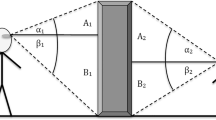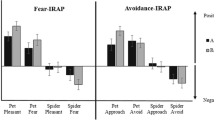Abstract
The nonrandom distribution of situational fears has been explained by evolutionary survival relevance of specific fears. Thirty-eight stimuli were taken from the literature on “preparedness” and were scored on fearfulness, objective dangerousness, and spatiotemporal unpredictability by three separate groups of students. The same items were scored on survival relevance by 15 biologists. Fearfulness of cues significantly correlated not only with survival relevance but also, and even more strongly, with dangerousness and unpredictability. While the fear/survival relevance association virtually disappeared when the “unpredictability” contribution was partialed out, the fear/unpredictability correlation was only marginally affected when controlling for survival relevance. This suggests that nonrandomness of feared stimuli may result from the spatiotemporal unpredictability that is attributed to these stimuli. The current practice of using snakes and spiders as “phobia-relevant,” and flowers and mushrooms as “neutral,” cues was not justified by the ratings of the 15 independent experts.
Similar content being viewed by others
References
Agras, S., Sylvester, D., & Oliveau, D. (1969). The epidemiology of common fears and phobias.Comprehensive Psychiatry, 10, 151–156.
Arntz, A., & van den Hout, M. A. (1987). Generalizability of the match/mismatch model of fear.Behaviour Research and Therapy, 26, 207–223.
Bennett-Levy, J., & Marteau, T. (1984). Fear of animals: What is prepared?British Journal of Psychology, 75, 37–42.
Bregman, E. (1934). An attempt to modify the emotional attitude of infants by the conditioned response technique.Journal of Genetic Psychology, 45, 169–198.
Cook, E. W., Hodes, R. L., & Lang, P. J. (1986). Preparedness and phobia: Effects of stimulus content on human visceral conditioning.Journal of Abnormal Psychology, 95, 195–207.
Costello, C. G. (1982). Fears and phobias in women: A community study.Journal of Abnormal Psychology, 91, 280–286.
Dawson, M. E., Schell, A. M., & Tweddle Banis, H. (1986). Greater resistance to extinction of electrodermal responses conditioned to potentially phobic CSs: A noncognitive process?Psychophysiology, 23, 522–561.
Deitz, S. R. (1982). Individual differences in electrodermal response conditioning and self-report of discomfort: A phobia analogue.Physiological Psychology, 21, 239–245.
Delprato, D. J. (1980). Hereditary determinants of fears and phobias. A critical review.Behavior Therapy, 11, 79–103.
De Silva, P., Rachman, S., & Seligman, M. E. P. (1972). Prepared phobias and obsessions: Therapeutic outcome.Behaviour Research and Therapy, 15, 65–77.
Dimberg, U. (1986). Facial expressions as excitatory and inhibitory stimuli for conditioned autonomic responses.Biological Psychology, 22, 37–57.
Eifert, G. H., & Schermelleh, K. (1985). Language conditioning, emotional instructions and cognitions in conditioned responses to fear-relevant and fear-irrelevant stimuli.Journal of Behavioral Therapy and Experimental Psychiatry, 16, 101–109.
Emerson, E., & Lucas, H. (1981). “Preparedness” and the development of aversive associations.British Journal of Clinical Psychology, 20, 293–294.
Eysenck, H. J. (1979). The conditioning model of neurosis.Behavioral and Brain Sciences, 2, 155–166.
Freud, S. (1909). Analyse der Phobie eines fünfjährigen Knaben.Gasammelte Werke, Vol. 7. London: Imago.
Freud, S. (1926). Hemmung, Symptom und Angst.Gesammelte Werke, Vol. 14. London: Imago.
Gray, J. A. (1979). Is there any need for conditioning in Eysenck's conditioning model of neurosis?Behavioral and Brain Sciences, 2, 169–171.
Hugdahl, K., & Kärker, A. C. (1981). Biological vs. experimental factors in phobic conditioning.Behaviour Research and Therapy, 19, 109–115.
Kirkpatrick, D. R. (1984). Age, gender and patterns of common intense fears among adults.Behaviour Research and Therapy, 22, 141–150.
Marks, I. (1977). Clinical phenomena in search of laboratory models. In J. D. Maser & M. E. P. Seligman (Eds.),Psychopathology: Experimental models (pp. 174–213). San Francisco: Freeman.
McNally, R. J. (1981). Phobias and preparedness: Instructional reversal of electrodermal conditioning to fear-relevant stimuli.Psychological Reports, 48, 175–180.
McNally, R. J. (1986). Pavlovian conditioning and preparedness: Effects of initial fear level.Behaviour Research and Therapy, 24, 27–33.
McNally, R. J. (1987). Preparedness and phobias: A review.Psychological Bulletin, 101, 283–303.
McNally, R. J., & Foa, F. B. (1986). Preparedness and resistance to extinction to fear relevant stimuli: A failure to replicate.Behaviour Research and Therapy, 10, 153–159.
Merckelbach, H., & van den Hout, M. A. (1988). Electrodermal and cardiovascular responses to phobia-relevant stimuli in a trace conditioning paradigm: Effects of instructions.Journal of Psychophysiology, 2, 81–193.
Merckelbach, H., van den Hout, M. A., & van der Molen, G. M. (1987). Fear of animals: Correlations between fear ratings and perceived characteristics.Psychological Reports, 60, 1203–1209.
Merckelbach, H., van der Molen, G. M., & van den Hout, M. A. (1987). Electrodermal conditioning to stimuli of evolutionary significance: Failure to replicate the preparedness effect.Journal of Psychopathology and Behavioral Assessment, 9, 313–326.
Merckelbach, H., van den Hout, M. A., & van der Molen, G. M. (1988). The phylogenetic origin of phobias: A review of the evidence. In P. Emmelkamp (Ed.),Three prespectives on anxiety disorders: Biological, behavioral and cognitive models. Amsterdam: Swets (in press).
Mineka, S., & Kihlstrom, J. F. (1978). Unpredictable and uncontrollable events: A new perspective on experimental neurosis.Journal of Abnormal Psychology, 87, 256–271.
Öhman, A. (1986). Face the beast and fear the face: Animal and social fears as prototypes for evolutionary analyses of emotion.Psychophysiology, 23, 123–145.
Öhman, A., Fredrikson, M., & Hugdahl, K. (1978). Towards an experimental model for simple phobic reactions.Behavioral Analysis and Modification, 2, 97–114.
Öhman, A., Dimberg, U., & Öst, L. G. (1985). Animal and social phobias: Biological constraints on learned fear responses. In S. Reiss & R. R. Bootzin (Eds.),Theoretical Issues in Behavior Therapy (pp. 123–175). New York: Academic Press.
Orr, S. P., & Lanzetta, J. T. (1980). Facial expressions of emotion as conditioned stimuli for human autonomic responses.Journal of Personality and Social Psychology, 38, 278–282.
Pavlov, I. P. (1928).Lectures on conditioned reflexes. New York: International.
Rachman, S. (1977). The conditioning theory of fear acquisition: A critical examination.Behaviour Research and Therapy, 15, 375–387.
Rachman, S. (1978).Fear and courage. New York: Freeman.
Rachman, S., & Lopatka, C. (1986). Match and mismatch in the prediction of fear-I.Behaviour Research and Therapy, 24, 387–393.
Rachman, S., & Seligman, M. E. P. (1976). Unprepared phobias: “Be prepared.”Behaviour Research and Therapy, 14, 333–338.
Saigh, P. A. (1984). An experimental analysis of delayed post-traumatic stress.Behaviour Research and Therapy, 22, 679–682.
Seligman, M. E. P. (1971). Phobias and preparedness.Behaviour Therapy, 2, 307–320.
Seligman, M. E. P. (1975).Helplessness: On depression, development and death. San Francisco: Freeman.
Seligman, M. E. P., & Hager, J. L. (Eds.) (1972).Biological Boundaries of Learning. New York: Appleton-Century-Crofts.
Turner, S. M., & Michelson, L. (1984). Obsessive-compulsive disorders. In S. M. Turner (Ed.),Behavioral theories and treatment of anxiety (pp. 239–277). New York: Plenum Press.
Vaitl, D., Gruppe, H., & Kimmel, H. D. (1985). Contextual stimulus control of conditional vasomotor and electrodermal reactions to angry and friendly faces: Transswitching — Yes! Preparedness — No!Pavlovian Journal of Biological Science, 20, 124–131.
Valentine, C. W. (1930). The innate bases of fear.Journal of Genetic Psychology, 37, 394–419.
Winer, B. J. (1962).Statistical principles in experimental design. New York: McGraw-Hill.
Author information
Authors and Affiliations
Additional information
This study was supported in part by a grant from the Dutch Organization for Fundamental Research (ZWO/Psychon, 560-268-001).
Rights and permissions
About this article
Cite this article
Merckelbach, H., van den Hout, M.A., Jansen, A. et al. Many stimuli are frightening, but some are more frightening than others: The contributions of preparedness, dangerousness, and unpredictability to making a stimulus fearful. J Psychopathol Behav Assess 10, 355–366 (1988). https://doi.org/10.1007/BF00960628
Accepted:
Issue Date:
DOI: https://doi.org/10.1007/BF00960628




